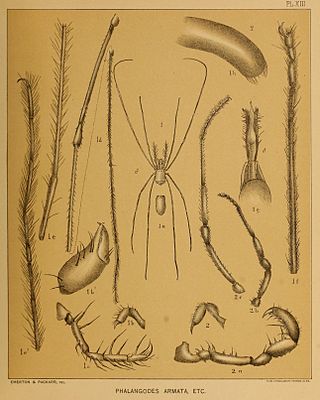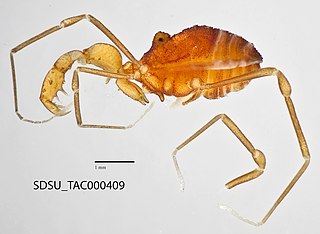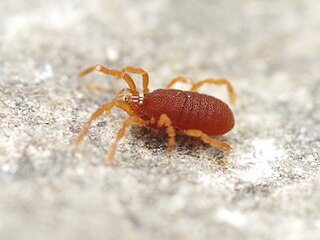
The Opiliones are an order of arachnids colloquially known as harvestmen, harvesters, harvest spiders, or daddy longlegs. As of April 2017, over 6,650 species of harvestmen have been discovered worldwide, although the total number of extant species may exceed 10,000. The order Opiliones includes five suborders: Cyphophthalmi, Eupnoi, Dyspnoi, Laniatores, and Tetrophthalmi, which were named in 2014.

Cosmetidae is a family of harvestmen in the suborder Laniatores. With over 700 species, it is one of the largest families in Opiliones. They are endemic of the New World with a Nearctic-Neotropical distribution where a large fraction of the diversity of Opiliones are represented by this single family. Cosmetidae have the northern extent of their range into the USA, where a small number species occur in the southern states. However, the family is especially diverse in Mexico, Central America and northern South America; especially the Andean realms. Their range also extends further south into Argentina and southern Brazil, but they are absent in Chile. Cosmetidae are prevalent in Amazonian region, but only relatively few also occur in Brazilian Atlantic Forest. Several species are also found in the Caribbean.
Escadabiidae is a small neotropical family of the harvestman infraorder Grassatores with six described species.
Kimulidae is a small neotropical family of the harvestman infraorder Grassatores with about thirty described species.
Eutimesius is a genus of harvestmen in the family Stygnidae with five described species. All species are found in South America.

Dalquestia is a genus of harvestmen in the family Globipedidae with six described species. All species are found in North America.
Wespus is a genus of armoured harvestmen in the family Phalangodidae. There is at least one described species in Wespus, W. arkansasensis.

Vonones is a genus of armoured harvestmen in the family Cosmetidae. There are at least two described species in Vonones.

Neosiro exilis is a species of mite harvestman in the family Sironidae. It is found in North America.

Phalangodes is a genus of armoured harvestmen in the family Phalangodidae. There is at least one described species in Phalangodes, P. armata.

Undulus is a genus of armoured harvestmen in the family Phalangodidae. There is at least one described species in Undulus, U. formosus.
Paramiopsalis is a genus of harvestmen belonging to the family Sironidae. All species are found in Spain.
Parasiro is a genus of harvestmen belonging to the family Parasironidae with one described species. It is found in Southwestern Europe.
Cyphophthalmus is a genus of harvestmen belonging to the family Sironidae. It is found in Europe notably with several species in the Balkans and Turkey.
Asarcus is a genus of harvestmen in the family Gonyleptidae with four described species. All species are found in Brazil.
Bourguyia is a genus of harvestmen in the family Gonyleptidae with four described species. All species are found in Brazil.

Ebrosiro is a genus of harvestmen belonging to the family Parasironidae, it is monotypic with one described species. It is found in Southern Europe.
Cimmerosiro is a genus of harvestmen in the suborder Cyphophthalmi with three described species. All three species are found in Eastern Europe and West Asia.
Tirrenosiro is a genus of harvestmen in the suborder Cyphophthalmi with two described species. Both species are found in Southern Europe.
Imeri is a genus of harvestmen in the family Stygnidae with two described species. Both species are found in Brazil in the state of Amazonas.







